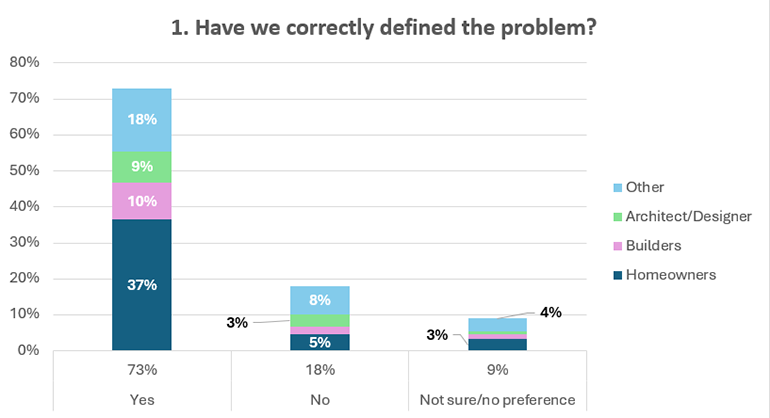Questions 1 and 2
On this page
What was asked
Question 1: Have we correctly defined the problem? Are there other problems that make it hard to build a granny flat?
Question 2: Do you agree with the proposed outcome and principles? Are there other outcomes this policy should achieve?
What was proposed
The problem definition identified that housing affordability is a key issue in New Zealand, and that there is both an increasing demand for, and a lack of supply of, small houses. Regulatory barriers have an impact on the number of small houses being built. With lower costs and easier processes, more smaller houses would likely be built.
The intended outcome of this policy is to increase the supply of small houses for all New Zealanders, creating more affordable housing options and choice.
Summary of feedback
Overall, 1,450 of 1,970 submitters answered these questions, with a further 685 and 544 submitters providing further information in the open-ended sections, respectively.
Figure 2: Graph detailing the response to question 1

Text description for graph - Figure 2: Graph detailing the response to question 1
Figure 3: Graph detailing the response to question 2

Text description for graph - Figure 3: Graph detailing the response to question 2
Homeowners
Most submitters agreed with the problem definition and supported the proposed outcomes and principles. The most common feedback was that consent processes were too cumbersome for both time taken and costs incurred, and that the policy would therefore help to reduce costs and support housing affordability. Another common theme from homeowners was that for dwellings of this type, consent processes were not proportionate to the risks where they are built by licensed building professionals.
Homeowners saw the benefits in a policy that achieves the proposed outcomes, noting that it would enable those with additional land to more easily turn this into something that can generate income in the form of rent. Others stated that it would create a more optimal use of land generally.
Advocacy groups, such as Age Concern, noted that granny flats should be accessible, suitable for those with mobility or other disabilities. Some councils also shared this view.
Iwi, hapū and Māori
Iwi, hapū and Māori submitters broadly agreed with the problem definition and outcomes, noting that the policy has the potential to assist in empowering rural communities and sustainable development.
However, one submitter noted that instead of barriers to building for Māori being considered out of scope of the proposal, they should be addressed, as should any legislation relating to housing. It was further noted that, if these challenges are ignored, there is a risk of perpetuating systemic inequalities that disproportionately affect Māori communities.
Councils
While many councils agreed with the problem definition, and that housing affordability is a major issue in many of their districts, some raised concerns that the proposed outcomes could not be achieved by enabling granny flats to be built more easily. A major theme from council submissions was that regulatory barriers to building were overstated, especially given the cost of consenting only made up a small fraction of the overall cost of building, while providing a significant level of quality assurance to the work. Some councils contested the claim that there is an increasing demand for smaller dwellings and that there is currently unmet demand for these housing alternatives. Further, a few council submissions noted that, if granny flats do proliferate due to the policy, this may exacerbate housing supply issues by taking up land in an inefficient manner.
Industry
Most industry submitters agreed with the problem definition, however some provided feedback on the proposed outcomes and principles contained in the discussion document. Feedback from some architects and designers suggested that housing affordability should be considered in the context of system-wide initiatives. They consider that such system-wide policy changes can have a more significant impact than discrete policies, such as enabling granny flats, that may only have a small impact for a select group of New Zealanders. These submitters noted that minor residential units are already enabled in many district plans around the country.
Some submissions suggested the intervention should seek to achieve additional outcomes. Builders raised that one outcome should be to ensure healthy, safe and durable buildings.

